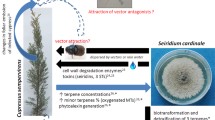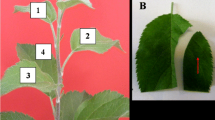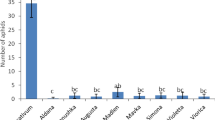Summary
Flavonoid compounds were studied in healthy and parasitized poplar branches following mistletoe (Viscum album L.) attack. Two poplar cultivars showing different degrees of resistance to mistletoe: sensitive “Fritzi Pauley” (FPL) and resistant “Vereecken” (VER) were used. Flavonoids were detected and localized using histofluorescence after treating frozen sections with two specific reagents. Total amounts of flavonoids were determined spectrophotometrically. Defence mechanisms were induced during penetration of the primary haustorium. They consisted of inner periderm development and flavonoid accumulation. These reactions were weaker in the FPL cultivar than in the VER one. In the latter, growth of the primary haustorium and the establishment of direct connections between the living host cells and parasite failed. The resistance of poplar cultivars to mistletoe was dependent on the production of defensive mechanisms against the pathogen.
Similar content being viewed by others
Abbreviations
- FPL:
-
Fritzi Pauley
- VER:
-
Vereecken
References
Agrios NG (1988) How plants defend themselves against pathogens. In: Plant pathology, 3rd edn. Academic Press, San Diego, pp 97–115
Armillotta A (1984) Etude de la résistance au guiViscum album. Thèse de 3e cycle, Université Pierre et Marie Curie, Paris
Andary C (1990) Documentation chimique et pharmaceutique pour l'AMM du MERALOPS comprimés. Laboratoire Allergan-Dulcis, Monaco, France
Cho EK, Goodman RM (1979) Strains of soybean mosaic virus: classification based on virulence in resistant soybean cultivars. Phytopathology 69: 467–470
Debost D, Senechal Y, Gohet E, Lambert C (1988) Les composés phénoliques des feuillesd'Hevea brasiliensis en relation avec la sensibilité auColletotrichum gloeosporioides. CR Acad Sci Paris Série III 307: 293–298
Friend J (1981) Plant phenolics, lignification and plant disease. In: Reinhold L, Harborne JB, Swain T (eds) Progress in phytochemistry, vol 7. Pergamon Press, Oxford, pp 197–261
Frochot H, Pitsch M, Wehrlen L (1978) Différences de sensibilité au guiViscum album L. de quelques clones de peuplierPopulus sp. In: 103ème Congrès Nat. des Soc. Savantes, Nancy, April, 1978, 1: 371–380
Hariri EB (1989) Polyphénols et résistance au gui (Viscum album L.), étude histocytochimique et analytique. Thèse de Doctorat de l'Université Pierre et Marie Curie, Paris
- Andary C, Sallé G (1987) New insights on the resistance against mistletoe (Viscum album L.) In: Weber H, Forstreuter W (eds) Proceedings IVth International Symposium on Parasitic Weeds, Marburg, August, 1987, pp 293–294
—, Sallé G, Andary C (1990) Mécanismes de résistance de quatre cultivars de peuplier en réponse à l'attaque du gui (Viscum album L.). CR Acad Sci Paris Série III 311: 439–444
Paupardin C (1972) Contribution à l'étude du rôle des composés phénoliques dans les phénomènes de morphogenèse manifestés par quelques tissus végétaux. Ann Soc Nat Bot Paris 13: 141–210
Royle DJ (1976) Structural features of resistance to plant disease. In: Friend J, Threlfall DR (eds) Biochemical aspects of plant—parasite relationships. Academic Press, London, pp 161–193
Sallé G (1977) Etude cytologique, cytochimique et histoautoradiographique duViscum album L. (Loranthacées). Thèse d'Etat, Université Pierre et Marie Curie, Paris
- Armillotta A, Frochot H (1984) Mechanism of resistance of four cultivars of poplar againstViscum album L. In: Parker C, Musselman L J, Polhill R M, Wilson A K (eds) Proceeding III. International Symposium Parasitic Weeds, May, 1984, pp 22–30
Sequeira L, Gaard G, De Zoeten GA (1977) Interaction of bacteria and host cell walls: its relation to mechanisms of induced resistance. Physiol Plant Pathol 10: 43–50
Vance CP, Kirrk TK, Sherwood RT (1980) Lignification as a mechanism of discase resistance. Annu Rev Phytopathol 18: 259–288
Author information
Authors and Affiliations
Rights and permissions
About this article
Cite this article
El Hariri, B., Sallé, G. & Andary, C. Involvement of flavonoids in the resistance of two poplar cultivars to mistletoe (Viscum album L.). Protoplasma 162, 20–26 (1991). https://doi.org/10.1007/BF01403897
Received:
Accepted:
Issue Date:
DOI: https://doi.org/10.1007/BF01403897




